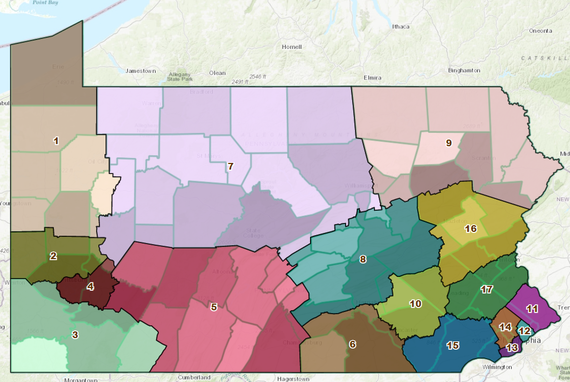Maya Sullum (Abington Heights HS, Lackawanna County) - Honorable Mention, Eastern Youth

About Maya: I am currently a junior and honor roll student at Abington Heights High School in Clarks Summit, PA. I actively engage in Teen Leadership Committee as president, Student Council as historian, Period at AHHS as treasurer, Interact Club, Student Senate, Tobacco Resistance Unit, Gender and Sexuality Alliance, Build Up, and Transition Team. Outside of school I participate in dance, band, cheerleading, and volunteering within my community.
Judges' Statement
Another returning mapper who clearly upped their game from previous rounds, Maya boasts the highest compactness score in the region among semifinalists (46.7%), while also exceeding the average on competitive districts (10). Those are not easy values to square. In her personals statement, she concentrated on her evolving process and came to some valuable conclusions after initially struggling. She also did a great job engaging with members of her community.

Endorsements: 1
Personal Statement
As I learn more about the structure of our government, I gain an appreciation for all the work put in to make it as democratic as possible. One aspect of this system is gerrymandering. Gerrymandering has gone unnoticed in the past, producing election results that do not represent the people of Pennsylvania's interests accurately. Our values and beliefs as humans vary, yet we all deserve to have these opinions represented fairly, which is why I am passionate about the redistricting issue, especially in Pennsylvania where we are comprised of such a wide range of views. While I was making my map, there were certain aspects I decided to focus on, including competitiveness, equal population, and cohesiveness. At first, I struggled to make certain districts as competitive as possible, due to Pennsylvania’s tendency to have major outlets of Democrats living in cities and relatively compact areas. However, gerrymandering in the past has been exploited to make districts that would produce election results favoring one party over the other. This practice does not accurately represent Pennsylvania since we have fairly equal percentages of Democrats and Republicans. Despite my struggles, I decided to focus on competitiveness to produce a map that represents the population of Pennsylvania’s views accurately. Also, I concentrated on the compactness of districts, despite Pennsylvania not having a specific law in place to promote this effort. I believe it is vital for a district to remain contiguous in order for the population residing in that district to feel as their representatives truly embody the values of the community. One final aspect I highlighted in my map was equal population. While federal regulation allows for 10% population deviation, I believe equal population is a significant factor in redistricting because all districts should be awarded the same amount of input. During the mapmaking process, I enlisted the assistance of members of my community for their input on what they viewed as the most important factors in redistricting. Most of the members of my community expressed their value in competitive districts, which encouraged me to focus on this aspect even more, since my community also viewed it as important to the democratic system. Overall, the experience of making a map for the 17 Congressional districts has influenced me to perform my civic duties more actively and has taught me a great deal about the redistricting issue.